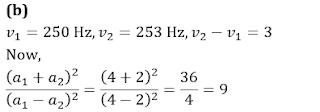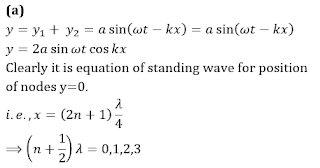JEE Advanced paper is considered to be one of the toughest entrance exams in India. Moreover, this Physics is considered the toughest subject because it is the most application-based. The student needs to get the basics right and then move on to mastering advanced concepts. Waves consist of nearly about 4-5 % of marks in the Physics section..
Q1. A travelling wave y=A sin(kx - ωt + θ) passes from a heavier string to a lighter string. The reflected wave has amplitude 0.5 A. The junction of the stings is at x = 0. The equation of the reflected wave is
Solution
(d)
As wave has been reflected from a rare medium; therefore there is no change in phase. Hence equation for the opposite direction can be written as
(d)
As wave has been reflected from a rare medium; therefore there is no change in phase. Hence equation for the opposite direction can be written as
Q2. Two vibrating tuning forks produce progressive waves given by, y1 = 4 sin(500πt) and y2 = 2 sin(506 πt). These tuning forks are held near the ear of a person. The person will hear
Q3. A sound wave of frequency 440 Hz is passing through air. An O2 molecule (mass =5.3 × 10-26 kg) is set in oscillation with an amplitude of 10-6 m. Its speed at the centre of its oscillation is
Q4. A string of length 2L, obeying Hooke’s law, is stretched so that its extension is L. The speed of the transverse wave travelling on the string is v. If the string is further stretched so that the extension in the string becomes 4L. The speed of transverse wave travelling on the string will be (n is an integer)
Q5. The vibrations of string of length 60 cm fixed at both ends are represented by the equations
y=4 sin(πx/15) cos(19πt)
Where x and y are in cm and t in s. the maximum displacement at x = 5 cm is
Where x and y are in cm and t in s. the maximum displacement at x = 5 cm is
Q6. Two identical sonometer wires have a fundamental frequency of 500 Hz when kept under the same tension. The percentage change in tension of one of the wires that would cause an occurrence of 5 beats/s, when both wires vibrate together is
Q7. In expressing sound intensity, we take 10-12 W/m2 as the reference level. For ordinary conversation, the intensity level is about 10^(-6) W/m2. Expressed in decibel, this is
Q8. A travelling wave represented by y = a sin(ωt-kx) is superimposed on another wave represented by = a sin(ωt+kx). The resultant is
Q9. A closed organ pipe and an open organ pipe have their first overtones identical in frequency. Their lengths are in the ratio
Q10. The frequency of a car horn is 400 Hz. If the horn is honked as the car moves with a speed us = 34 m/s through still air towards a stationary receiver, the wavelength of the sound passing the receiver is [velocity of sound is 340 m/s]














